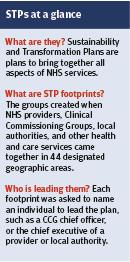
Last year 44 local areas in England were asked by NHS England to put together Sustainability and Transformation Plans (STPs) to outline future plans for NHS services. Their aim is to integrate health, social care and local government to accelerate the recommendations laid out in the Five Year Forward View, and to respond to challenges in local areas.
However, the distinct lack of communication and explanation of the STPs from NHS England and other national bodies has led the vast majority of NHS staff to misunderstand their purpose.
One of the most common criticisms is that the plans are purely a ‘cost-cutting exercise’, a way to do more with less. Kirsty Armstrong, a lecturer in primary care at Kingston university and an advanced nurse practitioner, warns that because the health service is already stretched ‘to try and reduce the expenditure and try to reduce the number of staff and what you pay the staff, people will just turn around and say that they can’t do it’.
However, NHS England told Independent Nurse that it was untrue that they were introduced to make financial savings.
The organisation says that instead STPs will ensure services work together, harness new technologies and make common-sense changes to improve patients’ lives.
This, it says, will include ‘making it easier to see a GP, giving more specialist care in or closer to people’s homes, speeding up cancer diagnosis and providing faster mental health treatment’.
The STPs will also decide on how to spend ‘increasing investment in the NHS, including a greater share for primary and community services’.
Yet, now the dust has settled, and think tanks and organisations have attempted to unpick the plans, reactions are still polarised.
A King’s Fund analysis based on interviews with senior NHS and local government leaders involved in four STPs found that engagement with primary care has been thin on the ground. This seems short-sighted considering increased government rhetoric on moving more care into the community.
None of the interviewees in the King’s Fund analysis believed that their STP footprint (see box) had been successful in engaging with primary care so far.
However, these interviews were conducted in a cross-section of only four areas that produced STPs so it cannot be assumed that all footprints have neglected primary care.
Jenny Aston, advanced nurse practitioner and RCGP nurse champion, says: ‘It doesn’t seem that there has been as much general practice input as would be necessary, in my view, to actually help change the way healthcare is delivered in a way that is going to be more cost effective and better for patients’.
Ms Aston says for effective long-term healthcare plans in each area, the STPs will have to address prevention, stemming the flow of increasing numbers of older sicker patients with complex diseases. ‘The key is going to be upskilling general practice and primary care so that they can take part in this.’
Chief executive of the Queen’s Nursing Institute Crystal Oldman believes some of the anxieties around STPs are not because of the plans themselves, but at the prospect of yet more change in the NHS. ‘It feels like we have just sorted out CCGs. Nothing ever seems to have time to embed before we are on to the next change.’
She thinks the STPs will be a good thing if they succeed in their aim of bringing organisations together and bringing more care into the home.
Ms Oldman hopes that investment in the primary care nursing workforce matches the change in focus of care delivery to more care being given at home and to support the use of GP practices and GP federations as alternatives to A&E.
‘We need to understand how to put the resources in to meet the needs,’ she says. This is a truism that some might say could be applied to the NHS as a whole.

References
1. The King’s Fund. Sustainability and Transformation Plans in the NHS. 2016. www.kingsfund.org.uk
